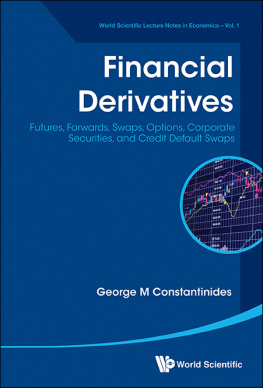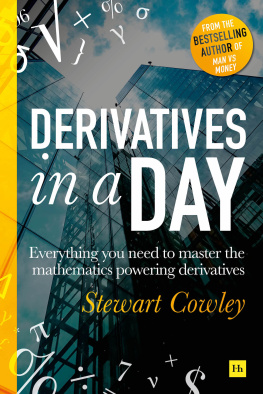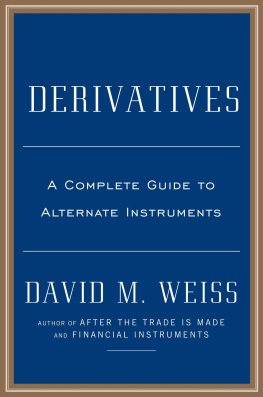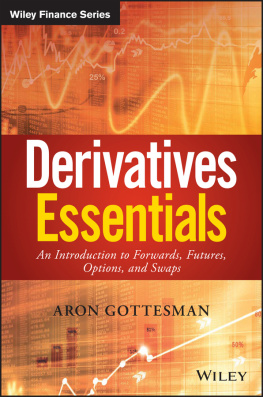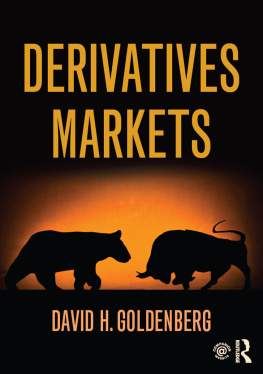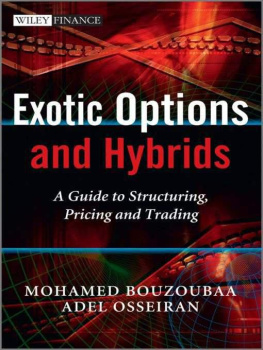Contents

Pricing Models of Volatility Products and Exotic Variance Derivatives
Chapman & Hall/CRC Financial Mathematics Series
Aims and scope:
The field of financial mathematics forms an ever-expanding slice of the financial sector. This series aims to capture new developments and summarize what is known over the whole spectrum of this field. It will include a broad range of textbooks, reference works and handbooks that are meant to appeal to both academics and practitioners. The inclusion of numerical code and concrete real-world examples is highly encouraged.
Series Editors
M.A.H. Dempster
Centre for Financial Research
Department of Pure Mathematics and Statistics
University of Cambridge, UK
Dilip B. Madan
Robert H. Smith School of Business
University of Maryland, USA
Rama Cont
Department of Mathematics
Imperial College, UK
Robert A. Jarrow
Lynch Professor of Investment Management
Johnson Graduate School of Management
Cornell University, USA
Introductory Mathematical Analysis for Quantitative Finance
Daniele Ritelli, Giulia Spaletta
Handbook of Financial Risk Management
Thierry Roncalli
Optional Processes: Stochastic Calculus and Applications
Mohamed Abdelghani, Alexander Melnikov
Machine Learning for Factor Investing: R Version
Guillaume Coqueret, Tony Guida
Malliavin Calculus in Finance: Theory and Practice
Elisa Alos, David Garcia Lorite
Risk Measures and Insurance Solvency Benchmarks: Fixed-Probability Levels in Renewal Risk Models
Vsevolod K. Malinovskii
Financial Mathematics: A Comprehensive Treatment in Discrete Time, Second Edition
Giuseppe Campolieti, Roman N. Makarov
Pricing Models of Volatility Products and Exotic Variance Derivatives
Yue Kuen Kwok, Wendong Zheng
For more information about this series please visit: https://www.crcpress.com/Chapman-and-HallCRC-Financial-Mathematics-Series/bookseries/CHFINANCMTH
First edition published 2022
by CRC Press
6000 Broken Sound Parkway NW, Suite 300, Boca Raton, FL 33487-2742
and by CRC Press
4 Park Square, Milton Park, Abingdon, Oxon, OX14 4RN
2022 Yue Kuen Kwok, Wendong Zheng
CRC Press is an imprint of Taylor & Francis Group, LLC
Reasonable efforts have been made to publish reliable data and information, but the author and publisher cannot assume responsibility for the validity of all materials or the consequences of their use. The authors and publishers have attempted to trace the copyright holders of all material reproduced in this publication and apologize to copyright holders if permission to publish in this form has not been obtained. If any copyright material has not been acknowledged please write and let us know so we may rectify in any future reprint.
Except as permitted under U.S. Copyright Law, no part of this book may be reprinted, reproduced, transmitted, or utilized in any form by any electronic, mechanical, or other means, now known or hereafter invented, including photocopying, microfilming, and recording, or in any information storage or retrieval system, without written permission from the publishers.
For permission to photocopy or use material electronically from this work, access
Trademark notice: Product or corporate names may be trademarks or registered trademarks and are used only for identification and explanation without intent to infringe.
ISBN: 9781032199023 (hbk)
ISBN: 9781032204321 (pbk)
ISBN: 9781003263524 (ebk)
DOI: 10.1201/9781003263524
Typeset in CMR10 font
by KnowledgeWorks Global Ltd.
Publisher's note: This book has been prepared from camera-ready copy provided by the authors.
Dedication from Yue Kuen Kwok:
To Oi Chun, Grace, Joyce, Yinan and Emma, for their love and support.
Dedication from Wendong Zheng:
To my wife Sherry and daughter Chloe, who have brought enormous love and happiness into my life.
Preface
Scope and Audience
Variance derivatives are financial securities whose payoff depends on the realized variance of an underlying asset or index return. With the introduction of variance derivatives in the financial markets since the mid-1990s, variance becomes in effect tradable asset and can be conceptualized as an asset class. The variance swaps on stock indexes began to become popular in 1998 and later extended to products on individual stocks. Starting in 2005, the third generation variance derivatives were structured, including the gamma and corridor swaps. The timer options were introduced in 2007. The VIX is a volatility index launched by the Chicago Board Options Exchange, which informs investors about the expected market volatility of the S& P500 index in the next 30 calendar days. The current VIX, launched in 2003, is based on the model-free volatility measure.
With the growth of trading volumes of variance and VIX derivatives, numerous pricing models have been developed in the literature in the last two decades that address pricing and hedging issues of various variance and VIX products. The earlier pricing models consider payoffs that are based on continuous realized variance, under which pricing procedures can be handled easier. However, actual contractual specifications of variance products are based on discrete realized variance measured on discrete monitoring dates. It has been observed that the discretization effects on the fair prices can be significant. The later pricing models focus on products with discrete realized variance payoffs. Most of these pricing models assume joint stochastic process of asset price and variance, or time changed Lvy process. Since discrete realized variance payoffs are highly nonlinear, these pose technical challenges in solving these pricing models.
In this book, we summarize most of the recent research results in pricing models of derivatives on discrete realized variance and VIX. We start with the presentation of volatility trading and uses of variance derivatives. We discuss the robust replication strategy of continuously monitored variance swaps using portfolio of options, which is one of the major milestones in pricing theory of variance derivatives. The replication procedure provides the theoretical foundation of the construction of VIX. We also discuss the approximate replication strategies for discretely monitored variance swaps and their exotic extensions. This book is made self-contained by adding one chapter on the characterization of Lvy processes and stochastic volatility models, the building block in the modeling of asset price dynamics in pricing models of variance and VIX derivatives. In the chapter on pricing of VIX derivatives, most of the pricing models in the literature include both the consistent approach and direct approach. In two separate chapters, we provide detailed exposition on deriving analytic pricing formulas of discrete variance swaps using various analytic methods and developing analytic approximation formulas for pricing options on discrete realized variance. The last chapter discusses various pricing approaches of the timer options, including the perturbation method and Fourier transform algorithms. We follow the rigorous style of showing detailed derivation of pricing formulas, providing sound formulation of pricing models and formal proofs of most technical results. Some illustrative numerical examples are included to show accuracy and effectiveness of analytic and approximation methods.


